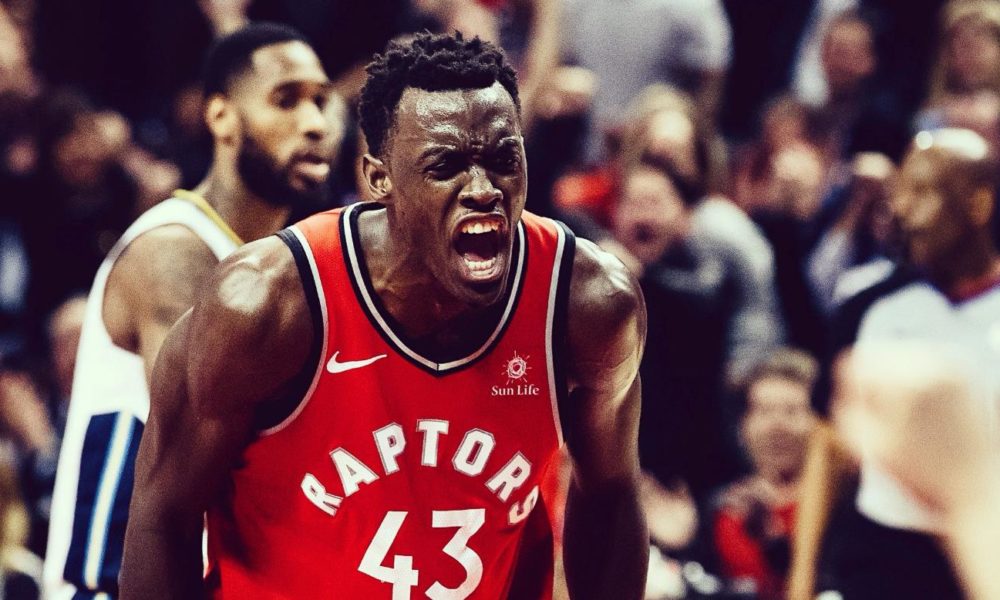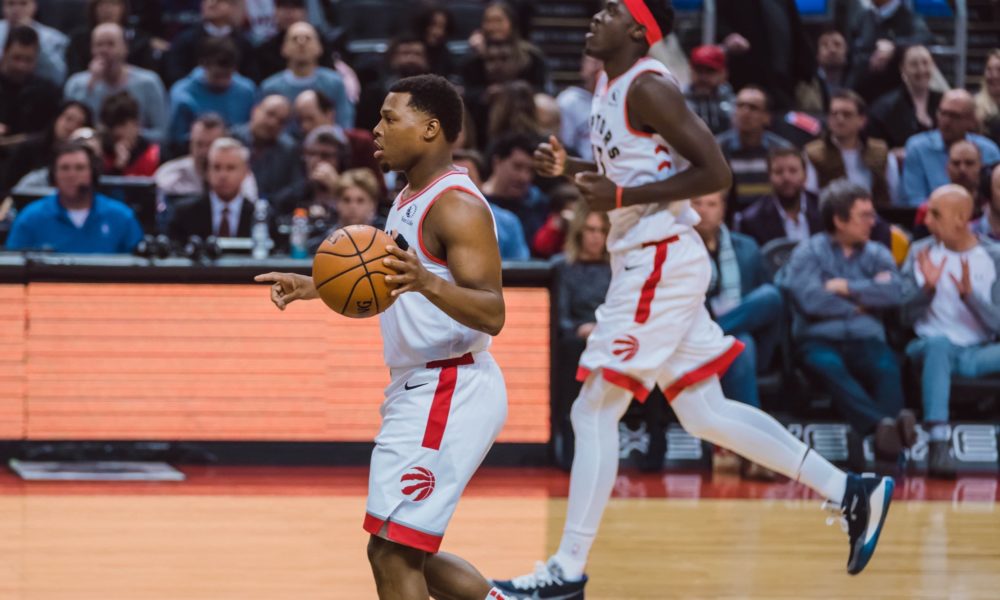The NBA playoffs are a crucible. The grasping fire of playoff defenses, with schemes as custom tailored as an Armani suit, and defenders as long as a Thomas Pynchon novel, can burn away lesser stars or lift the worthy to new heights. The Toronto Raptors have experienced both sides of the same dilemma. The Raptors this year will be faced with the same eternal question in the playoffs, but this time with a new twist.
Will Pascal Siakam be able to lead a team deep in the playoffs as its primary scorer?
To be fair, too much hand-wringing about Siakam’s playoff readiness is nonsense. He already lifted his game in the playoffs as a star contributor. Just last year, if you don’t remember, Siakam faced four of the best 10 or so defenders in the league as his primary defenders en route to winning a championship. The gauntlet of Jonathan Isaac, Joel Embiid, Giannis Antetokounmpo, and Draymond Green could well be the most difficult series of individual defenders Siakam will ever see for his entire career, and Siakam lifted his regular season scoring average from 16.9 to 17.9, though his effective field goal percentage dropped from 59.1 in the regular season to 50.8 in the playoffs.
Therein lies the rub. We know that Siakam will be able to score in the playoffs, likely even more than his current regular season average of 23.5 points per game. But will he be able to do so efficiently enough to keep Toronto punching above its weight while half-court defenders know every play in Nick Nurse’s profligate book?
Let’s start by comparing Siakam’s efficiency in individual types of plays with another star whom we know can dominated in the playoffs: Kawhi Leonard. For kicks, let’s include Siakam’s numbers from last year, as well.

Many of the effects that affected Siakam’s numbers going from the regular season to the playoffs have similarly taken place this year. That makes sense, as Siakam is, as happened in the playoffs, seeing opponents’ best defenders every night. This year compared to last, Siakam’s efficiency in virtually all areas is down, and he is taking more of his shots out of initiation sets like isolation and pick-and-roll, and fewer of his attempts coming in transition. Those trends started going into the playoffs last season, and they continued into the beginning of this year. The more Siakam transitions into a superstar, the more difficult his attempts will become.
But Leonard, and other superstars, see little drop off in their efficiency numbers from the regular season into the playoffs. Leonard saw little change in the frequency of his attempts, and aside from missing a few more of his catch-and-shoot attempts, his points per possession changed little from the regular season to the playoffs. Siakam saw efficiency drops in every category from the regular season to the playoffs last year, though some of his numbers — particularly in isolation and on spot-up attempts — have rebounded this season. If Siakam were to maintain his efficiency from the 2019-20 regular season into the playoffs, it would be a win for Toronto. If there’s any sort of drop-off, as happened last year, it would be a problem.
So, can we project Siakam’s regular season efficiency into the playoffs? That’s the million dollar question. Let’s look at some individual plays to try to get a feel for how defenses attack Siakam, and how that’s changed over time. Here’s a bucket from each of the 2018-19 regular season, the 2019 playoffs, and the 2019-20 regular season. This will anecdotally prove that the way defenses have adapted to Siakam has altered the framework through which he attempts his shots.
Last regular season, particularly early on, Siakam was completely unfettered by help defenders. In the clip above, he waltzed to the rim with each of Karl-Anthony Towns and Jeff Teague watching, able to stunt into the lane and help, but choosing not to. Last playoffs, Siakam saw more help, certainly, but he was still able to take his time in the post against a mismatch with Evan Fournier. Then this year, a Siakam drive struck such fear in the defense that Boston sent help from the strong side corner — traditionally a cardinal defensive sin — to try to deter Siakam at the rim.
The very structure of Siakam’s attempts have changed. It makes sense, given the level of attention Siakam now sees from all five defenders on the court, that his efficiency as a pick-and-roll handler or in the post has declined. That the frequency of those more difficult attempts, as a pick-and-roll handler and in isolation, have increased this year is understandable, too. He’s simply not able to get as many easy looks any more now that he has the A1 column on every opponent’s scouting reports.
A good example of the difficulty level of Siakam’s looks is his three-point shooting. After taking the vast majority of his triples on catch-and-shoot attempts from the corner in past years, he’s taking almost half on pull-ups from above the arc now. He’s shooting 33.3 percent on them, which isn’t enough to win games on its own, but it is enough to make sure defenders at least guard him there. Gone are the days when Embiid lets Siakam launch away from above the arc. That in itself is a win, as Siakam cannot be defended by players waiting for him in the paint.
Another important note from the chart, now far above, is that it’s missing passing data. The numbers are taken from nba dot com tracking data, so it only includes shots and not passes out of each category of actions. Siakam is a brilliant passer out of the post, among other areas, so this data does not include one of the greatest benefits of running the offense through Siakam in certain areas. In fact, his passing has been hugely beneficial to Toronto of late. Here is a play that doesn’t show up on the stats sheet, in that it registers neither points nor an assist for Siakam, but it demonstrates how he has been using his increased defensive attention to benefit the team’s offense regardless.
Siakam draws a triple team and passes to a OG Anunoby, relocates, passes, cuts, draws a quadruple team, and then kicks to Anunoby again for a triple. That’s unbelievably advanced stuff, and it wouldn’t have happened last year for a couple of reasons. One, his passing feel wasn’t this advanced. But secondly, defenders wouldn’t have scrambled with such impassioned fear at the sight of him stepping a foot inside the paint. There are ways that Siakam uses such attention to benefit the offense, despite the ensuing downside that his efficiency is down across the board.
He is learning when to go quickly and draw the defense to create for others.
He is learning when to go slowly, recognize the defense is taking away passes, and keep the ball for himself.
There are numbers that weigh how a player benefits his team’s offense without scoring, or while scoring inefficiently. For example, this year Toronto’s offensive rating with Siakam on the court is 113.4 and off the court is 106.6. That gap of 6.8 is far smaller than last year’s 9.7 in the regular season (114.8 on and 105.1 off), but it’s larger than Siakam’s 3.9 from last year’s playoffs (109.0 on and 105.1 off). Of course, those numbers have a variety of other contexts, not the least of which is tied to the departure of Leonard. But they still mean something. How to rationalize Siakam’s gaps in on-off offensive rating in words? Well, even despite Siakam’s improved passing, his drop in efficiency this year is likely the cause of the smaller gap in his offensive rating. In the playoffs, will his on-off offensive rating shrink even further, to the extent that his presence on the floor puts a ceiling on Toronto’s offense?
Probably not, no. Go back to those three baskets that serve as anecdotes for the increased defensive attention Siakam has drawn. Frankly, there’s not much more defenses can do to stop Siakam than they’re already doing this year. He’s already drawing opponents’ best defenders, just like he was in the playoffs last year. For the first time in his career, he’s dealing with double- and triple-teams on a regular basis. He is already starting to make them pay with his passing. If teams send even more attention in the playoffs, that would have to benefit Toronto; wide-open shots for players like Kyle Lowry or Fred VanVleet is the equivalent of a Mount Vesuvius eruption on the basketball court, as the Milwaukee Bucks and Golden State Warriors well know.
So it’s likely, instead, that Siakam’s efficiency stays relatively consistent in the playoffs. Defenses can’t do much more against him than they’re already doing. He’ll face better defenders than he does in an average regular season game, and defenses will be better coached and readier for Siakam’s toolkit of moves. Those shouldn’t be dramatic problems, and they aren’t things Siakam hasn’t already experienced. The changes that altered Siakam’s game going from last year’s regular season to post-season probably aren’t possible this year.
In fact, there are reasons to believe that Siakam’s game will translate quite well to the playoffs this year. He’s taking a far more difficult buffet of shots than he ever has in the past. Gone are the days of all his attempts being catch-and-shoot corner triples, transition dunks, or cutting layups. Now, his diet is a relatively equal share between those easier categories and more difficult shots from isolation, the post, and the pick-and-roll. That’s a really good thing. In the past, playoff defenses choked off transition attempts, and he struggled to score in other areas. Now that he can hurt defenses from anywhere in practically any situation, there’s no cheat code defenses can take to short-circuit his offense.
Being good and balanced is probably better for the playoffs than being great and one-dimensional. Siakam is starting to lean more towards the former category than he ever has in his career. His shooting and passing are weapons to be respected, and largely as a result, Siakam is ready to lead Toronto into the playoffs.
It helps that Toronto is blessed with a consistent, playoff-proven cadre of secondary scorers. In whatever order, VanVleet, Lowry, Serge Ibaka, and even sometime Norman Powell fill the role of the team’s second-best scorer from night to night. If you compare that league-wide, Powell’s 15.3 points per game is actually tied-most (with Kendrick Nunn of the Miami Heat) for any team’s fifth-highest scorer. That’s sort of an arbitrary distinction, but it’s meaningful in that the Raptors have a collection of secondary initiators and finishers who can lift the load from Siakam’s shoulders on any single night.
Siakam lifts his teammates’ play, and they help carry the burden so that Siakam doesn’t have to play superhero every night. There’s a circular benefit that inherent to any good, deep team, and that too will bear fruit in the playoffs. That advantage should help offset the fact that Siakam is probably not ready to bear the playoff load of a Kawhi Leonard. Siakam’s game is moving in the right direction, but it’s not there yet. That Leonard scored in the same way and at the same rate in the regular season last year as the playoffs is unbelievable; Siakam can’t do that, at least not yet. But his team is ready to carry a larger load, and Siakam himself has molded his game to withstand the crucible of the playoffs.
The fires of the playoffs are coming for Toronto. We’ve seen past Raptors teams collapse, and we’ve seen one other win the whole thing. This time, how Pascal Siakam’s growing game translates to the playoffs will largely determine whether the Raptors melt or harden in the flames.



